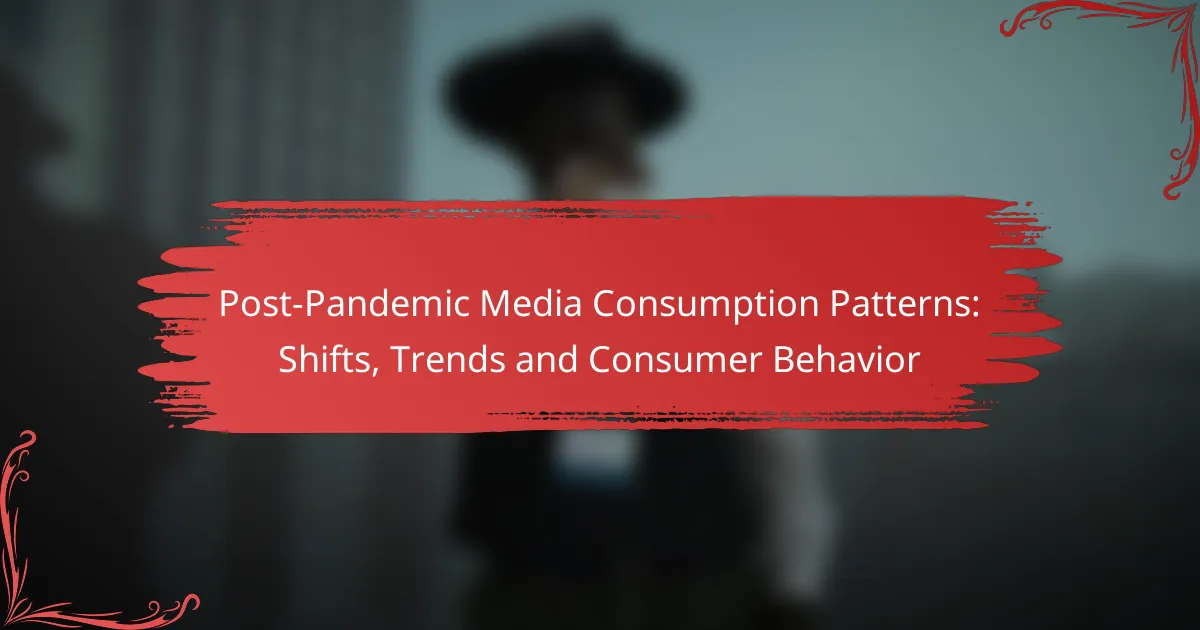In the wake of the pandemic, media consumption patterns in the United States have undergone a profound transformation, with a notable shift towards digital platforms and a decline in traditional media usage. Consumers are increasingly favoring streaming services, mobile content, and podcasts, highlighting a preference for on-demand and personalized media experiences. This evolution is further influenced by demographic factors, such as age and income, which shape how different groups engage with various media formats.

How has media consumption changed post-pandemic in the United States?
Post-pandemic, media consumption in the United States has shifted significantly, with a marked increase in digital platforms and a decline in traditional media. Consumers have embraced streaming services, mobile content, and podcasts, reflecting a broader trend towards on-demand and personalized media experiences.
Increased streaming service subscriptions
Many Americans have turned to streaming services for their entertainment needs, leading to a surge in subscriptions. Popular platforms like Netflix, Hulu, and Disney+ have reported significant growth, with millions of new users joining during and after the pandemic.
This shift has prompted traditional cable providers to adapt, often offering bundled streaming options to retain subscribers. Consumers now enjoy a vast array of content choices, from movies to original series, often at competitive prices compared to cable packages.
Shift towards mobile media consumption
The pandemic accelerated the trend of consuming media on mobile devices, with smartphones and tablets becoming primary sources for news, videos, and social media. Users are increasingly accessing content on-the-go, leading to a rise in mobile-specific platforms and applications.
As a result, content creators are focusing on optimizing their offerings for mobile formats, ensuring that videos and articles are easily accessible and engaging on smaller screens. This shift highlights the importance of mobile-friendly content in reaching today’s audience.
Rise in podcast listenership
Podcast listenership has surged in the post-pandemic landscape, with millions of Americans tuning in for entertainment, education, and news. The convenience of podcasts allows listeners to engage with content while commuting, exercising, or multitasking at home.
Many creators are capitalizing on this trend by launching niche podcasts that cater to specific interests, leading to a diverse range of topics and formats. Brands are also exploring podcast advertising as a way to connect with engaged audiences, making it a valuable medium for both creators and advertisers.

What are the key trends in consumer behavior after COVID-19?
Post-COVID-19, consumer behavior has shifted significantly, with a marked increase in demand for flexible, personalized media experiences. Key trends include a preference for on-demand content, a heightened focus on local news, and greater engagement with social media platforms.
Preference for on-demand content
Consumers increasingly favor on-demand content, allowing them to watch or listen at their convenience. This trend reflects a desire for control over viewing schedules, with many opting for streaming services that offer extensive libraries of films, series, and music.
Platforms like Netflix, Hulu, and Spotify have seen substantial growth, as users appreciate the ability to binge-watch shows or curate playlists. This shift has led traditional broadcasters to adapt by offering their own on-demand services.
Increased focus on local news
There is a growing interest in local news, driven by the need for relevant, community-focused information. Consumers are turning to local news outlets for updates on health guidelines, local events, and community issues, which they find more pertinent than national news.
Many local news organizations have enhanced their digital presence, providing easy access to news through websites and social media. This shift emphasizes the importance of supporting local journalism in a post-pandemic landscape.
Higher engagement with social media platforms
Social media platforms have seen a surge in user engagement, as people seek connection and information during and after the pandemic. Platforms like Facebook, Instagram, and TikTok have become primary sources for news, entertainment, and social interaction.
Users are not only consuming content but also creating and sharing their own, leading to a vibrant online community. Brands are leveraging this trend by increasing their presence on these platforms to connect with consumers directly and authentically.

How do demographic factors influence media consumption patterns?
Demographic factors significantly shape media consumption patterns, affecting preferences for platforms, content types, and viewing habits. Age, income, and education level are key determinants that influence how different groups engage with media.
Millennials favor streaming over traditional TV
Millennials are increasingly turning to streaming services instead of traditional television. This generation values flexibility and on-demand content, leading to a preference for platforms like Netflix, Hulu, and Disney+.
Streaming allows Millennials to watch shows and movies at their convenience, often leading to binge-watching habits. As a result, traditional cable subscriptions have seen a decline among this age group, with many opting for subscription-based models that fit their lifestyle.
Older adults prefer news broadcasts
Older adults typically gravitate towards traditional news broadcasts rather than digital platforms. Many in this demographic appreciate the reliability and structure of scheduled news programs on television.
This preference is often influenced by familiarity and comfort with established media formats. While some older adults are adopting online news sources, a significant portion still relies on local and national news channels to stay informed.
Gen Z leads in social media usage
Gen Z is at the forefront of social media consumption, utilizing platforms like TikTok, Instagram, and Snapchat more than any other age group. This generation engages with media in short, visually-driven formats that cater to their fast-paced lifestyle.
Social media serves not only as a source of entertainment but also as a primary means of communication and information sharing. Brands targeting Gen Z must prioritize social media strategies to effectively reach and engage this audience.

What are the implications for advertisers in the new media landscape?
The new media landscape presents significant implications for advertisers, necessitating a shift in strategies to effectively reach and engage consumers. Advertisers must adapt to changing consumption patterns and preferences to maintain relevance and effectiveness in their campaigns.
Need for targeted advertising strategies
Targeted advertising strategies are essential in the current media environment, where consumers expect personalized experiences. Advertisers should leverage data analytics to segment audiences based on demographics, interests, and behaviors, ensuring that messages resonate with specific groups.
Utilizing platforms that allow for precise targeting, such as social media and search engines, can enhance campaign effectiveness. For example, using Facebook Ads to target users based on their recent online activity can yield higher engagement rates compared to broad-spectrum advertising.
Importance of engaging content formats
Engaging content formats are crucial for capturing consumer attention in a crowded media landscape. Advertisers should focus on creating visually appealing and interactive content, such as videos, infographics, and live streams, which are more likely to hold viewers’ interest.
Incorporating storytelling elements can also enhance engagement. For instance, brands that share authentic narratives about their products or services tend to foster stronger connections with their audience, leading to increased brand loyalty.
Shift towards digital ad spending
The shift towards digital ad spending is a prominent trend, with many advertisers reallocating budgets from traditional media to digital platforms. This transition is driven by the growing number of consumers engaging with online content, making digital channels more effective for reaching target audiences.
Advertisers should consider investing in programmatic advertising, which automates the buying process and allows for real-time adjustments based on performance metrics. This approach can lead to more efficient use of ad budgets and improved return on investment.

How can brands adapt to changing media consumption habits?
Brands can adapt to changing media consumption habits by leveraging data analytics, embracing multi-channel marketing, and enhancing user experiences on digital platforms. Understanding consumer preferences and behaviors is crucial for effective engagement and retention.
Utilize data analytics for consumer insights
Data analytics allows brands to gain valuable insights into consumer behavior and preferences. By analyzing metrics such as engagement rates, viewing patterns, and demographic information, brands can tailor their content and marketing strategies to better meet the needs of their audience.
Consider using tools like Google Analytics or social media insights to track user interactions. Regularly reviewing this data can help identify trends and shifts in consumer habits, enabling brands to adjust their approaches in real-time.
Invest in multi-channel marketing approaches
Multi-channel marketing involves reaching consumers through various platforms, such as social media, email, and traditional media. This approach ensures that brands can engage with their audience wherever they are, increasing the likelihood of conversion.
For effective multi-channel strategies, brands should create cohesive messaging that resonates across platforms. Experimenting with different channels can help identify which ones yield the best results, allowing for optimized resource allocation.
Enhance user experience on digital platforms
Improving user experience on digital platforms is essential for retaining consumers in a competitive landscape. Brands should focus on creating intuitive, user-friendly interfaces that facilitate easy navigation and quick access to content.
Consider implementing features like personalized recommendations, fast loading times, and responsive design to enhance user satisfaction. Regularly collecting feedback from users can also provide insights into areas for improvement, ensuring that the digital experience meets evolving consumer expectations.

What frameworks can guide media strategy adjustments?
To effectively adjust media strategies post-pandemic, organizations can utilize frameworks such as the 4Ps (Product, Price, Place, Promotion) and the AIDA model (Attention, Interest, Desire, Action). These frameworks help in understanding consumer behavior shifts and aligning media efforts with current trends.
Understanding the 4Ps Framework
The 4Ps framework focuses on four key elements that influence marketing strategies. Product refers to the media content itself, which should be tailored to meet changing audience preferences. Price involves considering subscription models or advertising costs that reflect current market conditions.
Place emphasizes the channels through which media is distributed, such as streaming platforms or social media, which have gained prominence. Promotion involves crafting messages that resonate with audiences, leveraging insights gained from data analytics to enhance engagement.
Applying the AIDA Model
The AIDA model provides a structured approach to capturing consumer attention and driving engagement. Attention can be garnered through eye-catching visuals or compelling headlines that address current interests. Interest is built by delivering relevant content that speaks to the audience’s needs and preferences.
Desire is created by showcasing the value of media offerings, such as exclusive content or unique experiences. Finally, Action is encouraged through clear calls-to-action, prompting users to subscribe, share, or engage with the content.
Adapting to Consumer Behavior Shifts
Post-pandemic, consumers have shifted towards more digital and on-demand media consumption. Understanding these behavioral changes is crucial for adjusting media strategies. For instance, there is an increased preference for mobile consumption, which necessitates optimizing content for smaller screens.
Additionally, audiences are more selective about the media they consume, often favoring personalized experiences. Utilizing data analytics to track viewer preferences can help in tailoring content and improving engagement rates.
Measuring Success and Adjusting Strategies
To determine the effectiveness of media strategies, organizations should establish clear metrics for success. Key performance indicators (KPIs) may include engagement rates, conversion rates, and audience growth. Regularly analyzing these metrics allows for timely adjustments to strategies.
It is also beneficial to conduct audience surveys or focus groups to gather qualitative insights. This feedback can inform future content development and promotional tactics, ensuring alignment with evolving consumer expectations.
